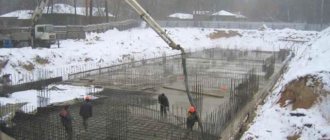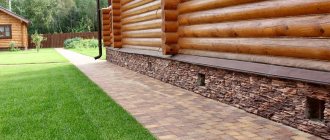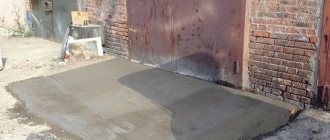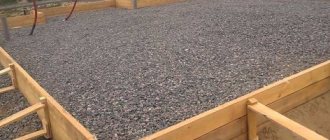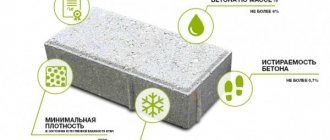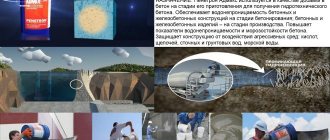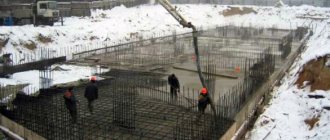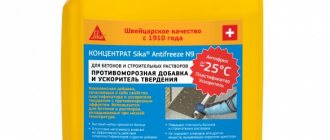Anti-freeze for concrete is a special anti-freeze additive that is introduced into the concrete solution in order to prevent the freezing of water in its composition, accelerate hardening and thus provide the ability to carry out work at sub-zero temperatures. The introduction of special additives into the concrete mixture also makes it possible to change the characteristics of the monolith for the better and improve a number of indicators.
Repair and construction work using concrete is traditionally carried out in the warm season. After all, for normal setting and hardening while maintaining all the characteristics, concrete needs an ambient temperature of around +15 degrees and a certain humidity. When the temperature reaches +5 degrees Celsius and below, the concrete will not harden at all, since at minus the water in it freezes instead of taking part in the hydration reaction.
In order to lower the freezing point of water and ensure the ability to work in cold weather, various anti-frost additives are introduced into concrete. There is a large selection of such additives: you can make them yourself, and there are ready-made mixtures that help improve the characteristics of concrete and simply require adding to the mixture. But before choosing any substance, you need to carefully study its advantages and disadvantages and properties.
How to make your own anti-frost additive to concrete?
To prevent the water from freezing and the mixture to set quickly, use an anti-frost additive in concrete, which you can make with your own hands. These are mainly salt substances that allow concrete to harden in frosty weather. They affect the temperature of the mixture, which results in faster setting and reduced financial costs due to a reduction in the amount of cement. However, experienced builders warn: additives should not be used if the concrete structure is operated at high humidity, since salts can negatively affect the reinforcement.
- Types of additives
- Pros and cons of antifreeze impurities
- How to do it yourself?
- Rules for adding to the solution
Recommendations for winter concreting
Due to its chemical composition, concrete at sub-zero temperatures is not able to maintain good quality.
If you want to lay the mixture in the cold, you should follow some rules:
- it is necessary to prepare auxiliary structures. It is necessary to clear the formwork from ice and sediment and heat the reinforcement structures and the bottom until the required temperature is reached. This will require heating elements;
- use of slab foundation. This makes it impossible to maintain the required temperature in icy cold weather. Experienced builders fill this type of foundation only when the mercury is above 0°C or slight frost;
- use of strip foundation as a base. Due to the possibility of performing the work in stages, this option is most suitable for the construction of housing in cold weather. It is better to create heating complexes for hardening concrete in certain areas;
- continuity of work. If the foundation must be poured in sections, each subsequent location must be filled before the first one sets;
- combination of methods. Practice shows that the best results can be achieved when using several methods of winter concreting.
Even despite all the accessibility of construction in the frosty season, it is necessary to remember that this entails extra costs of time, money and effort. Therefore, it is better to pour concrete in the warm season.
Purpose and scope
The operating principle of PMD is based on the properties of a complex of additives, which, when combined with water, change the freezing point, lowering it below zero. Concrete or mortar with an additive accelerates the process of setting and gaining brand strength.
The properties of antifreeze compounds are regulated by GOST 21411-2008, GOST 31384-2008.
Cement mortars with PMD are used in the following cases:
- construction in cold weather at sub-zero ambient temperatures;
- transportation in winter;
- the need to increase the strength of concrete;
- reducing solution consumption.
Additives are actively used in the northern regions, in winter throughout Russia. Used when there is a need for urgent repairs of reinforced concrete structures. At a temperature of +1...+5 °C, PMD is used to improve strength, uniformity, and ease of concrete laying.
Operating principle
The use of antifreeze additives allows you to pour mortars at temperatures down to -50ºС. They are liquid or powdery formulations added to the mixture. It is important to know that concrete additives added during frost provide only 30% hardening. Final hardening occurs after the monolith is defrosted.
There are several types of antifreeze additives, differing in their principle of action:
- Compositions that lower the freezing point of the liquid, as a result, the process of cement hydration continues, setting proceeds according to the standard mechanism;
- Sulfate-based additives accelerate the compaction of concrete, which releases excess heat, increasing the rate of cement hydration;
- Complex additives increase the solubility and activity of cement laitance, while compounds resulting from the reaction with water reduce its crystallization temperature.
Operating principle and types of frost-resistant compounds
Loading into a concrete mixer.
What to add to concrete at sub-zero temperatures is far from an idle question. There is no completely, 100% universal composition.
The choice depends on many factors, primarily on the temperature itself.
- The size of the monolith also has a big influence. Plus, you should take into account the purpose of the product, the fact is that different additives can change some of the physical properties of concrete and what is suitable for a strip foundation in a private house may not be suitable for the construction of a bridge or a large self-leveling plinth.
Warming up using the Thermos method.
How it works
As you know, the main task of water in a solution is to create conditions for the crystallization of the components of the solution, silicates, aluminates, and so on. In the language of professionals, this is called cement hydration.
Most comfortably, without additives, the solution hardens at a temperature of 15 - 20 ºС; everything higher and especially lower requires the creation of special conditions.
- The main task of this type of additive is to reduce the setting period of the solution and reduce the maturation time of concrete at low temperatures. That is, to reduce the level of freezing of water and at the same time not harm other processes occurring in the solution.
Dependence of strength gain on temperature.
Common compositions and methods of operation
- The most common materials for the manufacture of frost-resistant additives can safely be considered salts of monocarboxylic acids; among professionals this composition is known as “Potash”. The price for these compounds on the domestic market is quite reasonable.
- When pouring concrete at sub-zero temperatures, monocarboxylic acid additives must be strictly dosed. For each temperature, the number of additives is different. With such additives, you can prepare the solution for temperatures down to minus 30ºС. The lower the temperature, the more composition will be required.
Monocarboxylic acid salt.
Important: as mentioned earlier, the additive, if used incorrectly, can reduce other characteristics of the solution. Therefore, the principle, the more the better, can do harm here.
- The next leader in our market is sodium nitrite. The price for it is also not very high, but this substance has a strong, pungent, unpleasant odor. In addition, this composition can easily ignite. Upon contact with some types of modern plasticizers, poisonous and toxic gases may be released.
- The maximum temperature that sodium nitrate can hold is not lower than -15ºС. Experts recommend its use when preparing solutions using Portland cement or Portland slag cement. Adding this additive to aluminous cements is strictly prohibited.
- Sodium formate and calcium nitrate have a wide range of uses. In addition to the production of reinforced concrete products, these additives can be used in plaster mortars and mortars intended for bricklaying. But these compositions are used only in combination with a plasticizer, since due to the accumulation of salts, voids and efflorescence can form in the monolith.
Hardening accelerators
They are used as a compensator for delayed setting and when there is a need for accelerated setting of the mortar during concreting - i.e. when a quick transition to the next stages of work is required.
Do-it-yourself hardening, setting, hardening and hydration accelerators for cement-containing mixtures (concrete) at home
If you do not take construction chemicals that help speed up the setting of concrete, then there are not so many folk remedies that actually work. The most common method in industry to accelerate the hardening of concrete is its heat treatment with saturated steam. If you have a special camera, the use of this technology is most convenient.
If there is no special equipment, then they use electric heating of the concrete or formwork itself.
Electric heating of concrete with wires
The technology is quite simple and is mainly used at temperatures below -5C. The method allows you to accelerate the hydration of cement in domestic conditions and is based on the use of PNSV (Heating Wire Steel Vinyl Sheath) and a step-down transformer, which can be used as a welding machine.
Before pouring inside the reinforcement frame, loops from PNSV are laid, which will be heated by a step-down transformer. The cable must be laid carefully, secured to the frame and without fraying the insulation. If the insulation is damaged, a short circuit will occur through the ground and the entire loop will fail.
The advantage is the availability and relative cheapness of the method. The disadvantages are the inconvenience of laying the cable (laying loops).
Electric heating of concrete with electrodes
The technology for heating the formwork with electrodes is essentially similar to the method with PNSV. The only difference is that in this method the heating element is reinforcement and/or wire rod (8-10 mm). The technology is convenient for the construction of vertical concrete structures using vertical formwork.
For convenience, electrodes are inserted immediately after the concrete pouring stage at a distance of 0.6-1 m between the rods. Intervals are selected depending on the temperature according to the principle: the lower, the shorter the distance. The peculiarity of this approach is that heating occurs not at the electrodes, but at the liquid between them, according to the principle of a boiler made of two blades. So, for example, to warm up a pole, just one rod of reinforcement will be enough, which will be a phase, and the role of the earth will be taken on by the metal frame.
The disadvantage of heating with electrodes is the high energy consumption, because only one electrode consumes 45-50A.
Electric heating of concrete formwork
The name of the method speaks for itself - the heating elements are installed directly into the formwork panels.
The advantages of the technology of electric heating of formwork are:
- the ability to easily replace heating elements at almost any time,
- formwork can be of virtually unlimited height
- ability to use the method down to -25C
The disadvantages include the high cost when working with small and non-standard structures.
How to use
The choice of additive and the method of its application depends on the condition and material where it will be introduced. Any additives to concrete used at sub-zero temperatures are added to the solution with water, according to the instructions from the manufacturer. After thorough mixing, it is recommended to wait a while for this component to diffuse through the composition.
According to SP 70.13330.2012, in order for the composition to achieve the required strength, it is important that before the temperature of the composition reaches the level for which the additive is designed, it gains no more than 20% of the planned strength.
The consumption of antifreeze additive per 1 cubic meter of material depends on the average daily ambient temperature. Up to -5 degrees it is recommended to add up to 2% of the additive by weight of the solution, up to -10 degrees this figure increases to 3%, up to -15 degrees no more than 4%. In severe frosts, calculations are made individually for each type. The rate of hardening of the solution decreases, and maximum strength is achieved after the end of frost.
When adding plasticizers and PMD, certain operating rules must be followed. The recommended range for the solution to be poured is from +15 to +25ºС. To dissolve additives, a certain amount of water is required, which must be heated, this ensures complete dissolution of the substances. Sand and crushed stone used in the solution are also heated immediately before adding. Cement cannot be heated, as it will lose its astringent properties. The poured solution must be covered, this is especially true during snowfall.
Varieties
There are various antifreeze additives, each of which has its own mechanism of action. A popular additive is sodium carbonate, otherwise called potash. This is a powdery crystalline composition that accelerates the hardening of the concrete mixture. The use of an additive of this type reduces the technical characteristics of the material, including strength. To reduce this effect, sodium tetraborate is added to potash.
Attention! Potash is classified as a hazardous substance, therefore safety requirements are observed when working with it.
Sodium tetraborate is a complex substance consisting of sodium and calcium salts with the addition of ammonium. This is an additional antifreeze additive used with sodium carbonate. Without it, the structure can lose up to 30% of its strength after thawing and complete hardening.
Sodium nitrite is an effective antifreeze additive that reduces the crystallization temperature of water, accelerates the hardening of the composition, and has an anti-corrosion effect. Its use is dangerous, since sodium nitrite powder is a flammable, explosive, toxic substance. Used in frosts down to -25ºС. It cannot be mixed with lignosulfonic acids, since it releases toxic gas when interacting with them. Calcium nitrite has similar properties.
Sodium formate is an antifreeze additive for concrete, reducing the crystallization temperature of water and accelerating the hydration of cement. It is added in a proportion of no more than 6% of the total mass of concrete. To improve plasticization, naphthalene lignosulfonate is added to the additive.
Urea is a PMD, prolongs the liquid phase of water, and has virtually no effect on the setting speed.
Calcium and sodium chlorides, ammonia water reduce the freezing point, but have an increased corrosive effect. They have a strong effect on metal elements and are therefore not recommended for use in reinforced concrete products.
Tips for choosing
When choosing antifreeze additives, they take into account the method, circumstances of operation of the concrete structure, ambient temperature, brand, composition of cement, and quality of the additive. The PMDs used by specialists the most are considered optimal:
- potash (7% concentration) is suitable for Portland cement;
- sodium nitrite;
- sodium chloride is used for rapid hardening modifications.
When choosing PMD, you need to pay attention to the experience, image of the manufacturer, reviews in order to avoid purchasing a low-quality product.
The influence of temperature on concrete hardening
Concrete is a mixture of fillers - sand and crushed stone, bonded together with hardened cement laitance. When it reacts with water, it hydrates, then it hardens with the simultaneous evaporation of water. Critical strength at normal temperatures is achieved within one or one and a half days, depending on the humidity of the surrounding air.
The optimal temperature for the reaction to occur is about 20⁰C; the solution gains design strength within 28 days. To prevent water from evaporating too quickly in the first days, the concrete is covered with waterproofing.
What you need to know about concrete
The main components of concrete are cement, crushed stone, sand and water. When cement and water react, so-called hydration, a cement stone is formed, which holds together small and large fillers into a single monolith.
In factory conditions, an optimal regime is created for gaining strength in building elements. This is usually steaming with high humidity.
Pouring concrete in winter
On open-air construction sites, the monolith is poured under natural conditions. The most favorable air temperature for concrete work is considered to be 20-30°C and humidity 90%. Already within the first hours, setting occurs, and within a week or two the strength reaches 70%.
At the age of 28 days, the concrete mixture reaches brand strength. But the process does not end there. Several months, and sometimes years, pass, during which the density and strength characteristics of concrete increase.
If the ambient temperature decreases when pouring concrete, the process of cement hydration slows down. At temperatures below +5° it slows down, and when it reaches 0° it stops completely.
Dosage of antifreeze additive required for concrete to gain the required strength
| up to -5°С - 1% | 1 kg of additive per 100 kg of cement |
| up to -10°С - 2% | 2 kg of additive per 100 kg of cement |
| up to -15°C - 3% | 3 kg of additive per 100 kg of cement |
| up to -20°С - 4% | 4 kg of additive per 100 kg of cement |
| up to -25°С - 5% | 5 kg of additive per 100 kg of cement |
We must not forget that in the cold season, while negative temperatures persist, the strength of concrete with antifreeze additives does not exceed 30% of the possible design strength.
According to GOST 24211, the strength gain of “cold” concrete must be at least 30% of its brand strength 28 days after laying. Concrete will reach the remaining grade flowability at above-zero temperatures. Concrete can be loaded when it reaches 70% brand strength. Under “normal” conditions, this occurs 7 days after laying the concrete. Accordingly, at a temperature of +5 C, concrete will not reach 70% strength without additional heating. The use of high-quality plasticizing additives allows you to speed up this process
Advantages and disadvantages of additives
The main advantage of concrete with anti-frost additives is the ability to perform work all year round. Selected in the correct proportion, they improve the adhesion of the components, increasing the quality of the solution. They have other advantages:
- increasing service life due to concrete compaction;
- increase the plasticity of mixtures, making them easier to work with;
- the frost resistance of ready-made concrete increases, which is important for elements of load-bearing structures;
- the use of PMD is the cheapest method of filling at subzero temperatures;
- the use of additives reduces shrinkage during solidification, maintaining the integrity of the structure;
- anti-frost additives fill the pores of concrete, thereby significantly increasing its water resistance;
- some compositions significantly increase the corrosion resistance of the monolith, extending the service life of structures, buildings and structures significantly.
The use of antifreeze additives also has its disadvantages. If used incorrectly, the strength characteristics of concrete are reduced, so when working, you must strictly adhere to the instructions. Some additives are flammable and toxic, which must be taken into account when working with them. Even with additives, in frosty conditions the hardening rate will be relatively low. To achieve the required strength when laying in winter, a larger amount of cement is required, which increases the cost of construction.
Types of additives
High-quality additives for working at low temperatures allow you to work with concrete in temperatures down to -35 degrees. There are many types of additives - these can be accelerators, plasticizers, mobility regulators, modifiers, complex substances. They can be purchased ready-made or made yourself. The second option is more risky, since the exact recipes and properties of various substances with an antifreeze effect are not precisely known.
Many craftsmen use ordinary salt (sodium chloride) - it lowers the freezing point of the liquid and reduces the critical hardening time of the solution. To prepare such an additive, salt is dissolved in water and added to the mixture. For -5 degrees the concentration is 2% by weight of the solution, -15 - 4%. The disadvantage of this solution is its corrosion activity towards metal, so reinforced concrete structures cannot be filled with such a mixture.
Plasticizers
Organic polyacrylates, melamine resin or naphthalene sulfate are used as plasticizers. These additives have a plasticizing effect on the mixture and do not require large water consumption. The monolith becomes more waterproof, durable, concentrated (dense).
The mixture with the additive is much easier to place and is poured evenly, significantly saving water and energy costs. Thanks to the introduction of plasticizers into the composition, it is possible to accurately place the mixture in molds and eliminate the possibility of voids forming. Microparticles of the mixture retain moisture more effectively.
Strengthening
Such additives for concrete are also called hardening accelerators - the group includes calcium nitrate and chloride, iron and aluminum sulfate. Additives work by reducing the curing time of the mixture. At the moment of setting, concrete loses its plasticity, and during the hardening process it becomes strong.
Mobility regulators
These are special substances that make it possible to extend the period of work with a ready-made solution. They are divided into 2 types: additives that are introduced in minimal volumes and regulate characteristics (0.1-2%) and finely ground alloys (5-20%) to reduce cement consumption and without changing properties.
- The most effective are chemical plasticizers and superplasticizers.
- Additives increase the mobility of solutions and reduce water demand.
- Ligatures of the same class can have different effects on the solution.
- Superplasticizers are considered the best, which: increase the construction and technological properties of the mixture, increase the mobility of the solution, and reduce cement consumption.
Frost-resistant
These additives make it possible to carry out work at subzero temperatures without changing the technology or deteriorating the characteristics of the concrete solution.
Corrosion resistant
These modifiers are used where it is necessary to protect reinforced concrete structures from oxidation, which significantly extends their service life and prevents destruction and the negative effects of external factors.
Complex
There are additives that have several effects on the concrete mixture at once - they can simultaneously have a positive effect on the reinforcement and protect it, improve the performance properties of concrete, and increase the strength characteristics of a reinforced concrete structure.
DIY plasticizers
History knows many recipes and techniques for improving the characteristics of concrete. For example, already in the 19th century, to increase plasticity and adhesion, protein from a chicken egg was added to the solution; in the 20th century, after the advent of slaked lime (fluff), they switched to it. Nowadays, at home, washing powder or other detergents are sometimes added.
Making your own plasticizer for concrete and cement mortar at home
Recipe 1: add liquid soap or shampoo
It is introduced when mixing the mixture. Requires 200-250 ml per 50 kg of cement (hereinafter referred to as a bag).
- Mix water with 200-250 ml. liquid soap and pour into a bucket/trough to prepare the solution.
- We begin to add cement (1 bag) and filler.
- Mix the solution thoroughly and fill our forms or formwork with it.
Keep in mind that if you do not reduce the amount of water by 200-250 ml. (i.e. by the amount of liquid soap we added) - the concrete hardening time will increase by 3 hours.
Recipe 2: add washing powder
Pre-dissolves in water. It is introduced when mixing the mixture. 100-150 g per bag of cement is required.
- Dissolve 100-150 g of washing powder in warm water
- Mix water with the powder solution and pour it into a bucket/trough to prepare the solution.
- We begin to add cement (1 bag).
- Mix the solution thoroughly and fill our forms or formwork with it.
Commentary on Recipes 1 and 2:
It is worth considering that the soap solution is poured first and must be mixed very carefully - this will avoid the appearance of foam, which, when interacting with small particles of cement, neutralizes its properties - i.e. will spoil the cement-containing mortar.
What disadvantages and problems can be obtained from using such a soap plasticizer:
- Soap solutions wash salts onto the surface, which leads to the appearance of efflorescence (salt stains).
- The surface of the finished concrete is not covered with a special water-repellent film
- Liquid soap does not allow microbubbles to form inside the concrete solution, which makes it difficult for water to migrate through the solution. As a result, the concrete structure quickly becomes wet and, in poorly ventilated areas or without antiseptic treatment, can become covered with mold and mildew.
Recipe 2: add slaked lime fluff
This technology, perhaps with minor deviations, was widely used in the construction of brick houses in Soviet times. Slaked lime gives the solution increased adhesiveness and elasticity, adds adhesive capabilities, and also gives the concrete bactericidal properties and prevents the appearance of mold and mildew on the surface.
Like a soap solution, slaked lime is added first in an amount of no more than 15-20% by weight of cement.
Recipe 2: add PVA glue
The technology is widely used in country construction and renovation work in garages and apartments. PVA glue added to cement mortar improves its mobility, increases the final strength and water resistance of concrete.
It is introduced when mixing the mixture. Requires 200 g per bucket of solution.
Economic feasibility of application
The use of antifreeze additives in mortar or concrete, of course, increases the cost of these building materials.
It is economically feasible to use antifreeze additives in winter
However, this requires a cold-blooded calculation about what is more profitable:
- or save on additives, but mothball the construction site for six months, and in warmer months, re-deliver the equipment to the construction site and correct defects that formed during the winter, associated, for example, with the divergence of seams between rows of bricks and the general loss of strength of already erected structures;
- or spend money on antifreeze additives.
In accordance with the standard (specified in SNiP), the cost of a day of construction downtime in a mothballed state in relation to downtime in operating mode is 1:2. Yes, it’s cheaper, but the duration of conservation extends to 180 days.
Even the naked eye can see that it is more economically profitable not to stop construction, but to spend money on anti-frost additives. These financial losses are much less than those that will have to be incurred as a result of the conservation of the facility.
Why is concrete cast at low temperatures?
If temperatures below +5°C are harmful to concrete, why is concrete work carried out in such conditions?
The answer is simple: sometimes there is simply no choice.
There are many regions in Russia where optimal temperature conditions for concreting appear for a very short time. In fact, it is late spring or early autumn. It would be strange to cancel construction work the rest of the year.
But this is not the only reason; Sometimes winter concreting is done deliberately for the following reasons:
- in winter prices for building materials may be lower;
- on soft soils, in some cases, concreting foundations is possible only in winter;
- It is easier for heavy equipment to drive through frozen access roads.
The principle of operation of the antifreeze additive
Most developers try to start building the foundation in the warm season, because the optimal temperature for hydration, the chemical reaction between cement and water, as a result of which setting occurs, is +15 - +20 degrees.
But often circumstances force us to start construction in the cold season, and besides, winter construction has its own benefits and advantages. When the average daily temperature drops to +5 degrees, building codes regulate the transition to winter work, and here the use of anti-frost additives is necessary.
Vasily Shramko regional technical specialist in construction chemicals for concrete at TECHNONICOL Corporation
The use of the additive is advisable when the ambient temperature drops below +5 degrees, because At low temperatures, the chemical reaction of cement with water practically stops.
In addition to the fact that the reaction between cement and water stops and, accordingly, worsens, and in some cases the setting of the solution stops, water, freezing, expands in volume and destroys the structure of concrete. If the concrete mixture freezes after being placed in the formwork, then it is pointless to wait for the required strength to gain after thawing. Its structure will be loose, and its strength will be significantly lower than the strength of concrete of the same composition, but not subjected to freezing.
Therefore, when constructing reinforced concrete structures and monolithic structures at temperatures below 0 degrees, antifreeze additives are used. They have an antifreeze effect and accelerate the setting and hardening of solutions at subzero temperatures.
The action of the anti-frost additive is aimed at ensuring that the water included in the concrete mixture does not freeze, and the concrete structure gains its strength after laying.
The use of anti-frost additives allows the construction of foundations at temperatures from +5 to -25 degrees.
According to the principle of action, all antifreeze additives can be divided into two groups:
- Additives that lower the freezing point of the liquid phase of concrete; water does not turn into a solid state at -10 degrees and below.
- Additives that speed up the setting process.
When using additives in each of these categories, you must carefully read the manufacturer's instructions and also pay attention to the price tag. A cheap, low-quality antifreeze additive can worsen the performance of concrete.
High-quality antifreeze additives include special components - corrosion inhibitors, which do not contain aggressive salts that corrode reinforcement. They can be used in reinforced concrete, incl. densely reinforced. Unfortunately, this cannot be said about all PMDs presented on the construction chemicals market. It all depends on the composition.
A set of concrete care measures
The finished mixture begins to harden after pouring into a mold or trench, and lasts approximately 28 days. During this time, it gains strength and requires careful treatment. The process of maintenance and protection includes a number of measures, we list them:
- protection against rapid drying;
- ensuring the required temperature;
- exclude physical impact;
- prevent the influence of the external environment - sun, frost, rain, snow;
- protect the water in it from freezing;
- provide hydration in sub-zero temperatures.
The optimal temperature for gaining strength is 20 degrees, air humidity 80%.
Warmhouses to protect concrete - you can build even in cold weather
Over most of Russia, winter reigns for 6 months a year, significantly shortening the period suitable for construction. The main problem that prevents the construction of high-rise buildings in the cold season is the inability to provide concrete (foundations, screeds) with optimal conditions for setting and gaining strength. In accordance with established practice and building regulations, after pouring the cement-sand mixture, the ambient temperature should not fall below +20 0 C. But no one will stop work because of cold weather, the onset of autumn or winter. What should those who are forced to lay the foundation in January or December do? At the first stage, let's find out why pouring concrete at sub-zero temperatures is undesirable? The main reason is a large amount of water, without which the mixture will not be fluid and will not fill existing voids. If the ambient temperature drops below 0C, the familiar liquid transforms into a different state of aggregation, becomes ice and expands. The process of gaining strength is suspended or stops completely. If it's -4C outside, the concrete begins to freeze. When warming or a thaw occurs, the ice melts, returns to its original state, and the process of hardening of the screed resumes. It will not be possible to achieve the required strength.
Warming up concrete in winter To prevent negative temperatures from affecting hardening, it is necessary to create certain conditions using one of the methods listed below:
- modifiers are added to the solution to change the physical and chemical properties of concrete;
- electric heating;
- using hot water to prepare concrete;
- installation of greenhouses around the formwork and on top of the screed.
Next, let's look at the advantages and disadvantages of each option.
Use of additives and modifiers
Frost-resistant additives are designed to reduce the time it takes for concrete to gain strength. Manufacturers and sellers report that the foundation will not differ in strength from what is poured in the summer, that the water simply will not have time to freeze. Practice often differs from theory. If we talk about the disadvantages, it is important to highlight the following:
- limited temperature range of action. Additives will help if the air outside has not yet cooled below -50C. In severe frosts there is no need to talk about the effectiveness of the method.
- The reinforcement corrodes, quickly oxidizes and collapses. Adhesion to concrete deteriorates, the foundation becomes less reliable.
Electric heating as a way to fill screeds in winter
The most common options for winter heating of concrete are:
- current is passed through electrodes used as reinforcement;
- Before pouring the mixture, a special heating cable is laid.
The first option assumes that current from a welding machine or special equipment is connected to the laid reinforcement mesh. Voltage - 127 V (no more). If the foundation or screed is laid unreinforced, or fiberglass is used, special electrodes are introduced into the solution, and the current strength is increased to 380 V.
Electric heating as a way to protect concrete in winter. The second method leads to a significant increase in the cost of the project, since a special heating cable is laid along the entire reinforcing mesh, connected to a source of electricity. But it is important to recognize that the efficiency is higher in comparison with the first option. The main disadvantage of heating with electricity is that you will not be able to plug the equipment into an outlet once and calmly wait 30 days until the base gains strength. You will have to constantly monitor the temperature, which is difficult with a large foundation area. The likelihood of the surface layer drying out increases.
Using hot water to make concrete
Another way to pour concrete in winter conditions is to preheat the water to 60-70C. The advantages include the opportunity to obtain a high-quality base without additional costs. But there are much more problems:
- it is difficult to calculate the correct temperature taking into account the climatic characteristics of the region;
- The method only works in mild frost. If the thermometer shows -10C or lower, the effect will quickly disappear;
- It is difficult to prepare large volumes of concrete. The heated mixture is good for building a small private house, but not an industrial workshop.
The installation of heat guns or special greenhouses - awnings or canopies - will help solve all the problems described earlier. Supplying heat is a very expensive proposition. You will have to pay the same amount for electricity, gas or diesel fuel per month as the foundation itself costs.
Warmhouses made from canopies and awnings
A temporary tent made of special insulated fabric (PVC, Oxford, tarpaulin) is erected over the construction site. If the foundation is of significant size, the awning is installed sequentially over the areas under work. For small construction sites, the greenhouse is mounted above the entire facility. This allows you not to worry about uneven setting of concrete or subsidence of individual sections. The advantages of greenhouses made from awnings and canopies include:
- reusable. As soon as the concrete gains strength, the awning or canopy is removed and transported to another facility. For example, it will not be possible to remove the heating cable. The installation/dismantling operation of the structure requires 5-6 hours depending on the volume;
- maintaining uniform temperature and humidity throughout the entire perimeter.
Tarpaulin with a density of 180 g/m2 for the installation of shelters for pouring concrete Let's consider the main types of greenhouses used on construction sites.
Warehouses from Tarpaulin: advantages and disadvantages
Tarpaulin thermomats are most in demand in the construction of greenhouses. The base is isolon, protected from external influences by layers of laminated polyethylene. To counteract ultraviolet radiation, a light-stabilizing film is applied to the outer surfaces. The advantages of tarpaulin greenhouses include:
- the ability to maintain a single microclimate in a closed space with thermometer readings in the range from -40C to +80C. You can save on installing additional heat guns or roasters;
- moisture and vapor tightness. Tarpaulin, manufactured in accordance with GOST, can withstand up to 1000 mm of water column. Water, snow, and fog from the street do not penetrate inside the greenhouse;
- resistance to rot and mold for a long time;
- light weight (lighter than tarpaulin). No heavy frame is required; light guides are sufficient;
- elasticity. You can create structures of any shape without any problems. There are no stretch marks or deformed areas;
- minimum price among analogues;
- Easy to clean from dirt and dust. Small stains are removed with a sponge; for “general” cleaning, a hose connected to the water supply is used.
In fairness, it is necessary to note the relative disadvantages of tarpaulin greenhouses:
- An additional problem is that with regular use, the edges of thermomats fray. They have to be additionally glued or sheathed.
The assortment includes tarpaulin in blue, blue-green, yellow, black and white colors. It is possible to choose the best option based on size and type of connection of individual panels.
Warmhouses made of tarpaulin
For production, a special three-layer material is used. The top and bottom layers are tarpaulin made of linen or cotton fibers. Medium - isolon (sintepon). The advantages of tarpaulin greenhouses include:
- maintaining the temperature inside the “room” even with a sharp drop in temperature down to -60C;
- wear resistance and increased strength. Tarpaulin curtains do not lose their performance even after 5 years. Cuts can be easily repaired with patches that do not create cold bridges;
- the use of special impregnations avoids the formation of mold, rot, fungus, and protects against fire;
- water- and dirt-repellent properties. A water column thickness of up to 1000 mm will not harm the material and the structure as a whole.
Among the disadvantages of canvas greenhouses, we highlight:
- high density (up to 650 g/m2). The awning or canopy turns out to be quite heavy. In practice, this means special requirements for fastenings.
- this “point” is significant for aesthetes. The color range of the material is inexpressive and is limited to black and khaki variations.
In the assortment you can buy tarpaulin canopies with additional anti-rot impregnation, manufactured in accordance with the standards.
Oxford fabric warmers
Oxford awnings are made from particularly durable synthetic fabric (polyester or nylon).
A hydrophilic membrane is applied to protect against water. The middle layer is padding polyester with a thickness of 5 to 25-30 mm (thermal mats). Warm houses made from Oxford fabric The advantages of warm houses made from Oxford include:
- ability to withstand temperatures down to -60C;
- water- and dirt-repellent properties. No special effort is required for care. Dust, clay, dirt can be washed off with water from a hose.
But Oxford has many more shortcomings. And you need to know about them:
- to protect against external influences, the fabric is treated with either polyvinyl chloride (PVC) or polyurethane (PU). In the first case, the material becomes more rigid and more difficult to roll and store. The second treatment option gives Oxford greater flexibility and water-repellent properties;
- The greenhouses do not allow air and steam to pass through. Water evaporating from the concrete screed remains inside; a kind of greenhouse is created;
- nylon fabric accumulates static electricity, but at the same time burns out even from the smallest spark. Polyester does not burn, but is less durable than nylon;
- To create awnings and canopies, modifications of fabric with a density of 600 denier are intended.
PVC greenhouses
PVC greenhouses are based on fabric made of polyester or polyester impregnated with PVC. In construction modifications, polyethylene foam up to 10 mm thick is added. It is “thanks to” him that PVC greenhouses have the maximum weight among analogues - up to 1100 g/m2. Among the advantages of PVC awnings and canopies, it is necessary to highlight:
- resistance to water, mechanical shock, cuts, tears;
- maintaining the microclimate inside the greenhouse at outside temperatures down to -45C;
- wind and direct sunlight do not lead to deformation of the internal structure;
- long service life (up to 10 years);
- elasticity, flexibility, the ability to give almost any shape.
If we talk about the disadvantages of PVC, they are associated not with the physical properties of the fabric, but with the production method and raw materials, as well as the excessive weight of the finished products, which increases the cost of their delivery.
Finally
The trade and production company "Stroy Vybor" offers to buy at competitive prices the optimal means for protecting concrete from frost and winter cold snaps - awnings made of tarpaulin, PVC, tarpaulin and Oxford. All materials fully comply with building regulations, GOSTs, and are safe for humans and the environment. For use in Russia, no special permits or approvals are required.
Warmhouses for protecting concrete - can be built even in cold weather. Components from the world's leading suppliers (Russia, Europe, Asia) are used as raw materials. We have our own production, the best technologies and equipment have been selected. Tents for pouring concrete in cold weather can be purchased with delivery both in Moscow and Moscow Region, as well as in the regions of the country by transport companies of the buyer’s choice. To place an order, you can send an application by email or call the phone numbers listed on the website. A manager contacts each client. His task is to clarify the volume of delivery, delivery time, and type of payment. Don’t stop construction in winter, contact Stroy Vybor.
In this case, the structure of the concrete may be damaged, and microcracks will appear, which over the years will turn into ordinary cracks, and the process of destruction of the foundation will begin.
